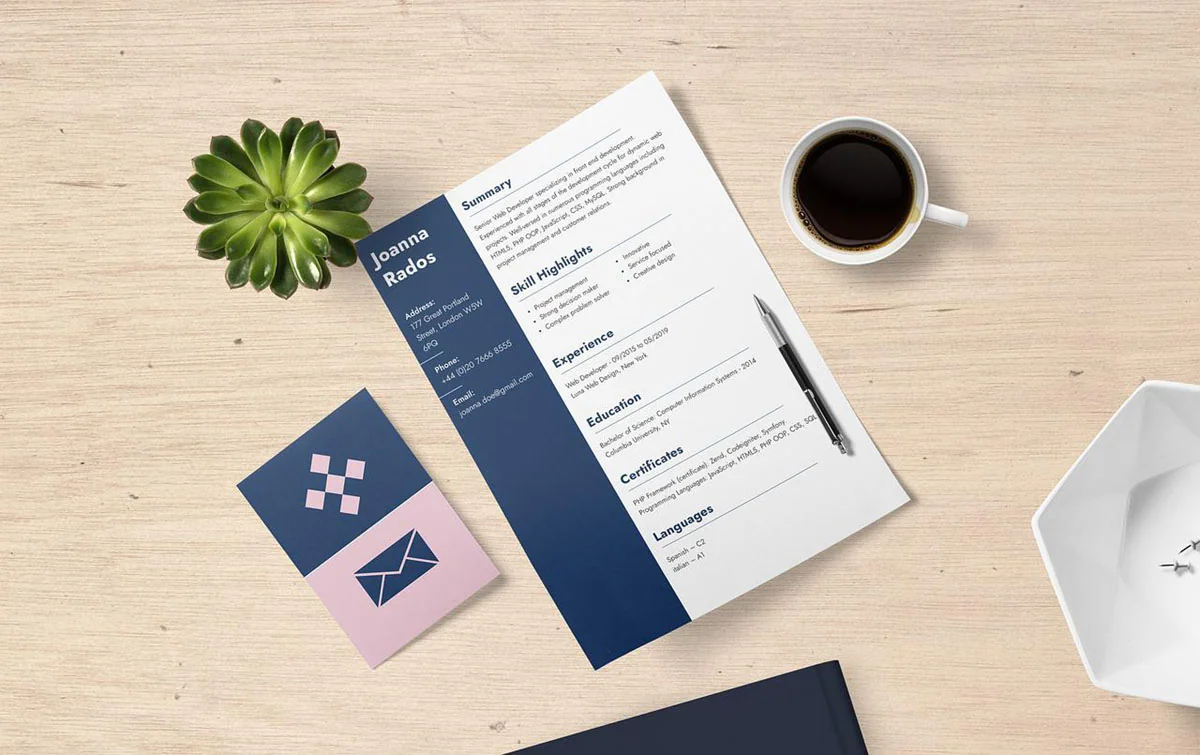Cover Letter 101: A Complete Guide to Getting Your Resume Noticed

The recruitment environment is changing. With shifting demands in working requirements, a new wave of applicants is entering the working world. With this wave comes a torrent of resumes, cover letters, and interactive, multimedia introductions. This makes standing out not only more important but significantly harder.
Your cover letter is your first impression. Down to the first words of the first sentence, it’s important not to allow your reader to lose focus. A bad one will certainly ruin your chances of anyone reading your resume. A perfect one will greatly improve them, but still, there’s no guarantee.
So, do you really need a cover letter? And if so, what exactly is it and how do you design one that stands out and really gets you noticed? If you want to find out, keep reading – we’ve got you covered.
What’s a Cover Letter?
A cover letter is an introductory insert from a time before modern communications technology, used for letting your prospective employee know who you are and what you’re applying for.
While technology has evolved, cover letters are still a useful and respected means of introducing yourself. It can take many forms: It might be an email, a video cover letter, or even a paragraph on your professional profile that will be tagged via social media or applicant tracking systems.
Whichever format is used, the principle is the same, and as such there are important fundamentals to consider. For example, while the main elements of a cover letter are introductory, this doesn’t mean referencing your work history or interesting moments in your life story is a good idea.
Essentially a cover letter is a written or recorded account of who you are professional, in the context of the role you are applying for. A cover letter can be unsolicited (a cold cover letter) or can be in response to a role opening up.
Either way, the information included needs to be relevant and concise to bring across your job fit and lead the recruiter to your resume without boring them. It does this by being brief, creating intrigue, and summarizing your fit for the role in just a few short paragraphs.
Is It Necessary?
You might be wondering, if you’re sending a resume with all this information in it already, do you need to attach a cover letter? To answer that, it’s worth pointing out the differences between the two.
A cover letter plays a different role than a resume. While a strong resume is almost always the most important part of your application, the cover letter acts as a wingman to pump up the readers and get them interested in reading your resume.
This complementary invocation of emotion is something that should be kept well out of a resume but fits perfectly into your introduction for it.
So, do you need a cover letter? Yes. It’s always good to assume that you need a cover letter in an application unless the listing specifies that it’s not necessary. A cover letter is the face of your application and will be critical for drawing the interest of your recruiter. In fact, a poll by Office Team found that 86% of executives valued cover letters in applications.
In the current era of reshuffling and remote work opportunities, the dynamics of recruitment and employment are changing. Applications for certain roles are as high as they’ve ever been and the need to stand out is therefore particularly great. In order to push your way to the top, you’re going to need a memorable introduction.
It’s useful to know that while a good cover letter won’t guarantee you the job (though it may significantly improve your chances!), a bad cover letter will guarantee that nobody will read your resume. So, how do you put one together? Let’s take a look at the basics.

Cover Letter 101
The first thing to remember about a cover letter is to respect your recruiter’s time. The person you will be introducing yourself too may be faced with 150+ applications a day, and simply won’t have time to follow a lengthy page of information.
Here are six cover letter 101 rules to consider:
- Rule number 1: Keep it Brief.
Many experts recommend that your cover letter should be readable in around ten seconds. This means being exceptionally relevant and concise. You may not be able to get it down to ten seconds, but keep in mind that by far the most important rule of the cover letter is to keep it short.
Do this by only focusing on what needs to be said to draw someone in and alert them to your fitness. More on that later.
- Rule number 2: Have a Tasteful Header
The cover letter needs to be framed with the date, your name and address, and other contact information. These can be placed at the top right, as in a traditional letter, but more modern styles can provide an aesthetically-appealing visual for your first impression.
Rather than having your details above the letter, consider having a header column to the left of your main text and use color combinations for accents. You can do this by following basic PowerPoint fundamentals or online templates. Pay attention to the tasteful use of white space, and don’t crowd the page.
One useful tip here is to have your job title under your name. Many cover letters that are uploaded are scanned by bots for keywords, so you want to take advantage of that where possible.
- Rule number 3: Start with a Hook
The first line of your cover letter should stand out from the crowd. If you’re competing with over 150 cover letters that day, you need to be fresh and intriguing. The first line should be a statement of connection to the company, and intention to work in the role you’re applying for.
To find a good hook, it’s useful to do your research. If you can find some industry professionals to talk to, you can glean some insight into the right statements to make in your cover letter hook that will show your motivation, energy, and willingness to learn to the recruiter in a single sentence.
- Rule number 4: Be Focused
Each sentence should have a reason for being there. Redundancy and irrelevant information are your enemy in this introductory letter, so don’t worry about listing your previous position or your name and background; this information isn’t immediately significant. Instead, focus on what you’re offering to the recruiter in this moment.
List relevant achievements; if your role isn’t looking for your years spent gathering leadership or admission skills, don’t put them in. It may be difficult to discard the fruits of your labor here, but remember that less is more, and don’t let pride get in the way.
- Rule number 5: Be Humble but Confident
Nobody finds cockiness attractive, but you do need to showcase what you’re selling and that you’re confident in your ability. For some, this can be a tricky balance to navigate, so do consider looking for outside inspiration if you need to, for examples of what sounds right and what doesn’t work.
Sticking to more balanced terms about your fit, such as “a powerful asset to the team” rather than “the perfect person for the job”. This is particularly necessary for a team player cover letter since the role will be looking for someone who works well with others, and not someone who is off-putting and full of themselves.
- Rule number 6: Your CTA
At the end of your cover letter, finish with a call to action. This may be in the form of your leading sentence to the resume or something simple as calling for an interview.
Thank them for considering you, and tell them you’re looking forward to meeting them for a follow-up. And/or, highlight the relevant part of your resume to start with, so encourage them to keep reading.
Formatting
To expand upon the previous section, it’s important to get a feel for the useful formatting that keeps things simple while including all of the above. Andrew LaCivita, founder of the Milewalk Academy suggests the following four sentences that apply to any means by which you will introduce yourself to your employer.
- In the first sentence, tell them exactly why you’re inquiring. Address them in a comfortable manner, with whatever sounds right to you – it could be “Dear Sir/Madam”, or if you have a name, use that. You could also use “Dear Hiring Manager” if it sounds like it fits. It’s usually better to find out the name of the recruiter, but make sure you spell it right! Then, immediately tell them you’re the reason you’re addressing them.
- Next, summarize what you offer and why you’re qualified State your experience briefly and why it’s a fit for the opening.
- Thirdly, in the same paragraph, draw attention to the top section of your resume to lead them to the most relevant information about your job fit. This is a leading sentence, to create curiosity and inspire the reader to continue.
- Lastly, thank them for their time and welcome the opportunity to connect to discuss your strength as a candidate for this role, or any other opening in their organization. This demonstrates both humility and the fact that you’re open to other roles and puts the idea into the recruiter’s head.
These four sentences cover everything you need to gather interest, cut to the chase, and don’t present a hurried recruiter with a wall of text that’s hard to navigate. They also allow the letter to function as a lead to your resume with very little reading time involved.

Cover Letter Example
Putting all these elements into practice, we can design a template for the content of a fictional cover letter. In this example, it’s for a remote role.
Your particular visual formatting will be done to your taste, but in this example, we cover the content basics to give you a head start and demonstrate all the above points in action.
_____________________________________________________
[Your Name]
[Job Title]
[Address]
[Contact Details]
[Their Name]
[Company]
[Address]
Dear [Recruiter Name],
I’m happy to inquire about the opening for [Remote Role]. I first noticed your company at [Career Fair/Convention] and have been following a number of similar organizations online for the past few years. It’s clear to me that [employer] stands out from the crowd.
What drew me in specifically, is the online culture of your staff and their outreach methods. Having collaborated remotely with [demonstrate fit] for [demonstrate experience] years, this role really appeals to me on a personal and professional level. I would therefore kindly request that you take a look at the four key points in my career profile at the top of my resume to highlight why I think I will be a valuable contributor to your team.
I’m very excited to hear what you think and look forward to your opinion on my strength for this role, or any other current opening in [organization]. Thanks for taking the time to read this, and I hope to hear from you soon.
Regards,
[Your Name]
_____________________________________________________
Clearly, the specifics of the role change the content of the cover letter somewhat, but from the above example it’s possible to spot how the key points and order of display can be fit into three short paragraphs that take little time to read, contain genuine personality and display job fit, motivation, and research skills; all backed up by experience referenced in the resume.
In the heading is the job title, used for keyword searches on uploaded applications. Then, in the first paragraph, there is a link to the company and a demonstration that you’ve been doing your homework by visiting related events.
The second paragraph demonstrates your job fit and experience and a personal desire to join the team. It then proceeds to present an intriguing point of interest in your resume to encourage the recruiter to look further.
Finally, before the intrigue wears off, it quickly ends with a gracious call for feedback, further demonstrating character and imploring the reader to act.
This template is easy to modify and does not take long to customize.
Customizing your Cover Letter
Each job is different, and it’s a good idea to create a bespoke cover letter; even usually a tailored resume as well, to find the best fit between the recruiter and the material. However, the template doesn’t need to change much.
Keeping in mind the key points and best practices, it shouldn’t take much time to knock up a new cover letter for each role, assuming you’ve done the homework to demonstrate your enthusiasm.
Getting your Resume Noticed
Following the Cover Letter 101 above will dramatically improve your chances of pulling in a recruiter. By using these guidelines and basic principles, you’re far more likely to draw their attention than the hundreds of other applicants who haven’t got a clue where to start. However, in an even more competitive environment, there is a way to stand out further by increasing the dimensions of your introduction.
As mentioned, advancements in technology have opened new approaches to cover letters and resume introductions in general. The traditional written cover letter is often converted from a 2D text presentation to a video introduction or even a more multimedia and interactive approach.
A video introduction follows most of the same rules as a traditional cover letter but opens up a wealth of other dimensions such as visual and audio presentation cues, while at the same time creating a more personal greeting with the recruiter.
These presentations are particularly useful for customer-facing roles or social media presence but can help you stand out for many more positions too. There is a lot more room for personality to shine through in a video cover letter.
From video cover letters to entire interactive resumes using integrated multimedia tools, Jabord helps you with the complete process, making you stand out and get your resume noticed in a climate where the traditionalists are falling behind.
An interactive resume puts all your cover letter principles into an enhanced application.
It can give agency to the recruiter and allow them access to all the relevant information in the order they see fit.
Conclusion
A cover letter comes in many forms. However, each form acts as a brief introduction and an overview of why you’re fit for the role you’re applying for. A good cover letter grabs the recruiter’s attention, respects their time, and humbly leads them to your resume.
By following a series of basic principles, you can condense your experience, desire, and character into three short paragraphs that engage the reader and greatly improve your chances of recruitment.
Should you want to take your cover letter to the next level, it’s worth considering multimedia approaches like video introductions and interactive resumes. For that, take a look at Jabord’s range of services and rapidly boost the power of your cover letter.



